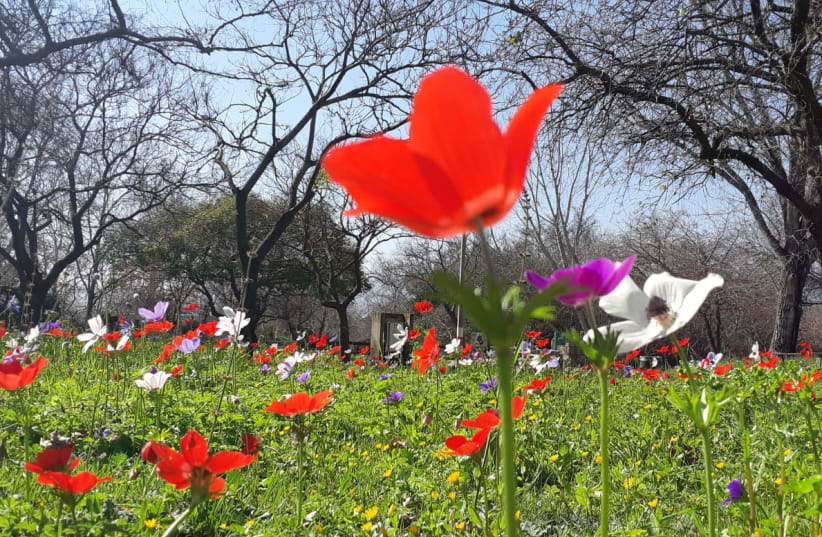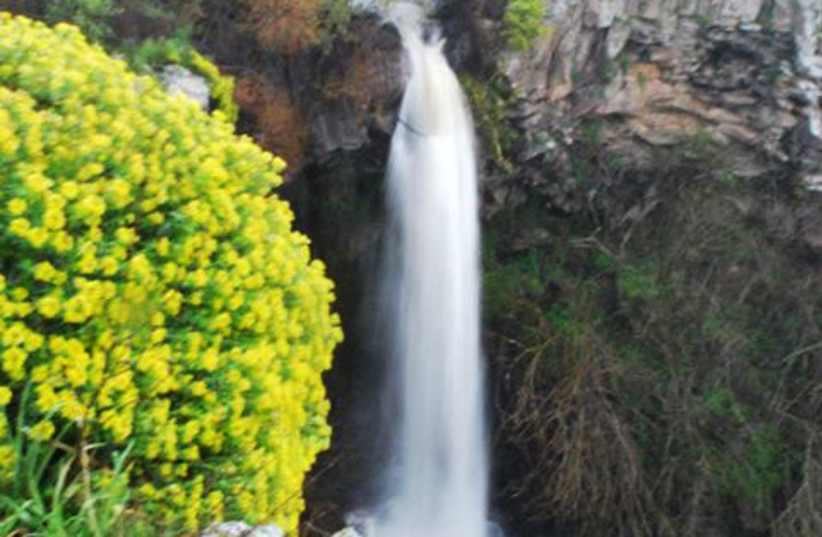The past few weeks have reminded all of us that Israel experiences serious winter weather at times. After being subjected day after day to freezing temperatures, downpours of rain and finally, snowfall in some areas around the country, it is time to tour around Israel and reap the benefits of all this precipitation. This winter has been much wetter than last year, and as a result, we could potentially see an even greater blossoming of seasonal flowers around the country. In other words, this is a great time to get out into nature and view Israel’s beautiful countryside. Below, you will find descriptions of four different locales that are currently experiencing great changes as a result of recent rains.
1. Horshat Tal
This is the absolutely most ideal time of year to visit Horshat Tal National Park, located at the foot of the Golan Heights. Currently, Horshat Tal is covered with colorful anemones and is a great place to view the white snow-covered Golan Heights.
Horshat Tal National Park, which is spread out over 175 acres, is full of robust, ancient oak trees, large grassy areas, a pond that is the recipient of water flowing from a number of streams and an impressive orchid preserve that includes a number of rare varieties. After entering the park, walk toward the overnight camping area. Along the way, you will notice that the grounds are carpeted with the seasonal anemones that are currently in full bloom. After you’ve captured the beautiful surroundings on camera, continue toward the pond filled by a number of creeks, including Nahal Tal, which originates at Kibbutz Dafna and later joins with Nahal Dan.
After another couple hundred meters, you’ll notice that the path starts winding among the over 240 Mount Tabor oak trees, some of which are hundreds of years old. One anecdote about Horshat Tal from Islamic tradition is that the Prophet Muhammad visited these woods with his companions, who stopped on this spot to give their horses a rest, back in a time before there were trees there. Tradition has it that they drove sticks into the ground in order to tether their horses. Once they’d rested, and were ready to continue on their journey, they saw that the sticks had transformed into huge trees – the same trees that offer us shade there today.
During the entire month of February, the Israel Nature and Parks Authority will be offering guided tours at Horshat Tal so that visitors can enjoy walking among the anemones and Mount Tabor oak trees. In addition, there will be drawing workshops on site.
Location: Horshat Tal National Park.Directions: From Kiryat Shemona, drive north on Road 98. About one km. after Hagoshrim, turn onto Road 918 and drive to the entrance of the park.
2. Nahal Meitzar
The southern Golan Heights is full of great hikes, many of which are accessible for families with kids. If you’re looking for a fun outing, Nahal Meitzar be right up your alley. This easy circular trail is especially fun after it’s been raining, so that you get to experience the Meitzar waterfall in its full glory. If you like the idea of hiking to the waterfall, but prefer something a little more adventurous and you have access to two cars, you can walk the entire 6 km. trail.
Location: Southern Golan Heights.Directions: Drive to Afik Intersection and turn right onto Road 789. On your left, you will see the starting point of the trail.
3. Hairusim (Irises) Waterfall
It seems like everyone has heard of Nahal Zavitan, but not many know about Hairusim Waterfall, which is located in the upper section of the Zavitan. The waterfall flows especially strongly after the winter rains have begun, and into early spring. The waterfall is extremely tall and the magnificent pool that forms below stays full of water all year long.
After Israel has had lots of rain – like we experienced over the last couple weeks – Hairusim Waterfall is absolutely gushing with water. The surrounding area is technically a restricted military area for exercises using live ammunition, so the area is only open to visitors on weekends.
Directions: Park your car at Hamapalim Intersection on Route 87. Walk 2 kilometers on a dirt road until you reach an open area near the cliff. Follow the path that circumnavigates and then leads down to the pool. Retrace your footsteps to return to your car at the end.
For more information, call: (04) 697-7224.
4. Yatir Forest
One of Israel’s most incredible forests is the Yatir Forest, located on the southern slopes of Mount Hebron. This 7,500-acre forest is home to millions of trees, and the only way to traverse it is on Road 316, an old road that was built by KKL-JNF many decades ago.
The Yatir Forest is important, as it is the only forest that was planted near Israel’s desert areas. The growth of these trees has had an extremely profound impact on the habitat of the region and has attracted animals that hadn’t previously lived there, such as wolves and partridges.
There are a number of great hikes in the Yatir region. My favorite is the one with the green trail markers that reaches Har Amasa, a moshav shitufi (a type of cooperative Israeli village). The trail begins at Metzudat Hayaaranim (Forester’s House Lookout), which was built in the 1960s when the KKL-JNF was planting trees in Yatir Forest. There’s a great view of the surrounding fields from the roof of the building.
Another spot that shouldn’t be missed is Hurvat Anim (Anim Synagogue). Here, you’ll see remains of the underground ancient city that is mentioned in the Book of Judges. At the site, you’ll see an ancient water cistern, a cave and a synagogue.
As well, visit in the Yatir Forest area is the large water reservoir, which has lots of picnic tables nearby. This is a great place to stop for a snack or lunch.
Location: Be’er Sheva area.Directions: Drive on Road 31. Pass Hura, then turn onto Road 316, which leads to the Yatir Forest parking area.
Translated by Hannah Hochner.

